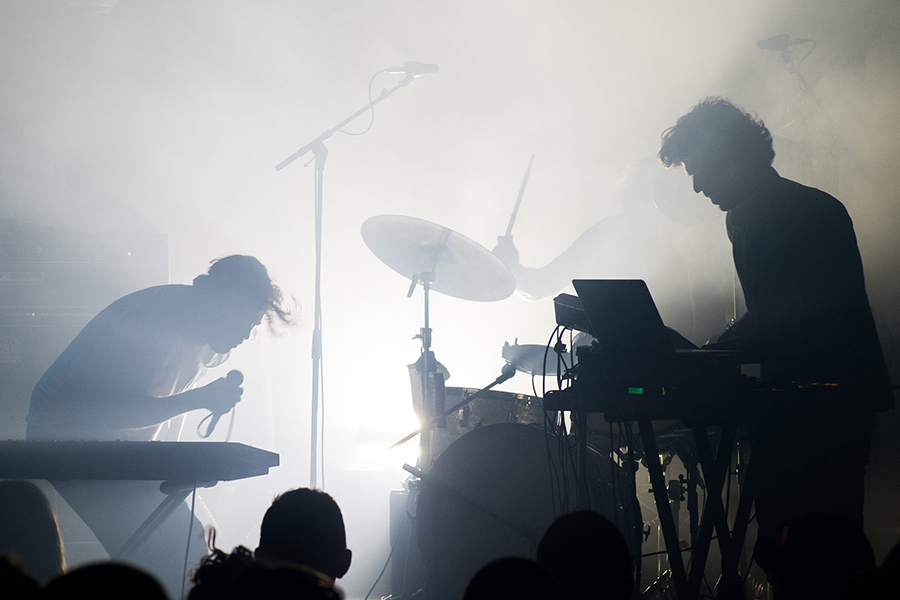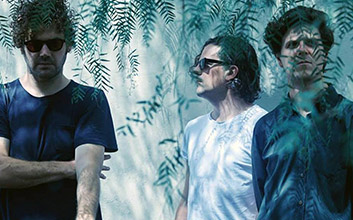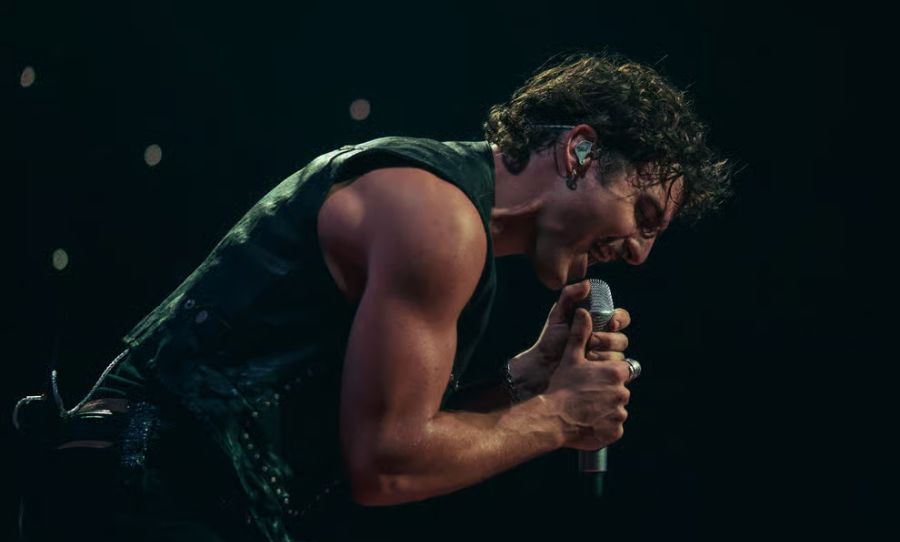For over a decade, PVT have been an unstoppable driving force in Australian electronic music. But with members living between Sydney and London for several years now, their recent live appearances have been few and far between.
That’s why we were completely stoked when they announced they’d be hitting the road in support of their brilliant record, New Spirit, which dropped earlier this year. Known for their rapturous, full-body-experience live shows, the tour is shaping up to utterly epic.
We wanted to know what kind of gear they’ll be taking on the road and what they were using on New Spirit, so we reached out to Richard, Dave and Laurence with some questions about their equipment. They replied with a 2000-word insight into how they craft their sound. Dive in, gear nerds.

Want to know how PVT craft their rapturous, full-body-experience sound? Here’s a 2000-word nerd out about synths, pedals, drum machines, and gear addiction.
HAPPY: I really dig how diverse PVT are with gear, and how inventive you get when combining sounds. Is there a place within your tunes that you always begin with when writing?
PVT: It always seems to start a different way. I guess for me it starts with a period of research and development. I try new software or synths and go through a period of intense listening of new (or old) music. We discuss a lot what we want to achieve next, and it occurs especially in relation to our previous statement.
Our last record was tight, well-constructed, generally short songs. We wanted our next one to be a bit more free flowing and exploratory. It felt more positive and genuine. And I think you can hear that in the music. We’re less trying to prove something these days I guess. When you first start out you’re trying to tick a lot of boxes and aim real high. When you’ve got more experience and skill behind you, you tend to naturally be hitting higher marks without even trying. Everything is a bit more effortless.
The way I use computers now is quite intuitive and instinctive and exploratory. I kind of didn’t put any limits on myself for how much I was allowed to use my electronic skills this time, but really the limit I incur on myself now is not overdubbing and layering like I used to – that’s kind of amateur. I tend try and do one thing with one sound at a time. Develop that one synth part or beat or melody all the way through, without suddenly falling into a safety net of layering 10 synths, in attempt to make sound ‘produced’.
I’m not sure I’ve really answered your question here but the process of using your ears and whatever tools you have before you is more interesting to me. Because the way we start songs always changes. Sometimes it’s a shitty mono drum beat made in Ableton. Sometimes it’s the lyrics. Sometimes it’s a chopped up vocal take. One song was written on acoustic guitar and vocal only, then re-recorded over an 808.
HAPPY: Since you don’t have a bassist, where or to who do you go to when trying to fill out your low end?
PVT: Yeah, this is an interesting one for us. I used to play much more live bass, on stage and on LP. But the last couple records it’s mainly bassy synths. Sometimes it’s arpeggiator that has a enough of bass in it – like on Kangaroo or Morning Mist. That’s all the Juno 6, which is fantastic for rhythmic baselines. Because it’s on board arpeggiator is analog, I trigger it with CV. So it’s not exact, it sounds more ‘live’ than sequencing it in Ableton or whatever.
Then something like Morning Mist I’ve got the rhythm going through the Roland RE-301 chorus echo – which again is tape so the rhythm is never exact. The 808 behind it is just on a loop, but again the 808 onboard sequencer is not in absolute computer time either. It’s subtle but it makes all the difference. I actually lost the audio of the 808 takes at one stage, coz we were transferring files between studios. So I replaced the beat with samples in Native Instruments Battery. And it just didn’t work.
It was amazing how much it just lost its groove. I played it to the guys and they were like hey it doesn’t sound like the first demo, what’s happened? I had to go back and re-record the 808. And it was a borrowed machine from Ben Hillier (who mixed the record) so I needed that exact machine to get its quirks. For there in the end. I think it was worth it.
HAPPY: What’s on your pedalboard right now?
PVT: Man, I haven’t changed pedals in a long while. I’m just not playing that much guitar. But I know I’ll go back to it. I just need to be inspired by it again. And I think part of that will be trying new equipment.
When sound bounces back to you and it feels and sounds good then that’s when you make your best stuff. That experience for me has mainly been with computers and machines lately. But if you wanna know… Line 6 DL4 has been a mainstay for a long while. SiB Mr Echo and the SiB Nick Nitro is a pretty gnarly fuzz. I’ve been meaning to replace that one. It’s a great sound but it just doesn’t suit the kind of music we’re making now.
I’ve got a Malekko Tremolo and a Fuzz. A Boss RE-20 which is great for the tap tempo delay. And I’ve been using an EH Voice Box for an octave Down effect on my voice. Tbh, it’s not ideal, it’s just a solution for touring. I’d prefer to use the original Boss VT-1, which I did in the studio, but it’s just unstable for touring.
HAPPY: How do you approach your signal chain/routing?
PVT: Ha, whatever works. Whatever sounds good. There’s no real method with that stuff. Maybe I have a method when mixing with plugins – if that’s what you mean? But as far as guitar pedals etc go that’s more just experimentation. And you develop an intuition for what works and what doesn’t for your sound.
HAPPY: You bring in quite a few vocal effects, is that in the box or on hardware?
PVT: Yeah, so like I mentioned I loved using the Boss VT-1 in the studio. Besides it being ‘analog’ it just has a nice slightly robotic sound. The EH Voice Box is rubbish to use as a deliberate effect, because it’s made for country singer-songwriters to harmonise with themselves, on cafe gigs or whatever. So they’ve made it sound really smooth, like it’s always hiding behind the main vocals. I don’t want that I want to hear the effect. But the reason I use it is because of real estate on the pedal board. I should probably invest in the new Roland Aira VT-3. But it all costs money. Anyone from Roland reading this? Send me a promotional copy? I would be using it on almost every song in our live set, I swear.
HAPPY: Why do you think more and more bands are combining live and electronic drumming?
PVT: Heh, unfortunately I don’t think the reason is mainly artistic, it’s more out of necessity. Studios and rehearsal time are expensive. When artists create a new song these days it often starts on the laptop in the bedroom or wherever, because it’s the cheapest quickest way. So it’s inevitable when it’s time to get on the road that there’s gonna be a mix of both. The Roland SPDSX has become a mainstay of live bands because of this.
Did I mention I love Roland products?
HAPPY: Drum samples. Where do you find them? Dare I ask how many you have saved up at this point?
PVT: Yeah just from anywhere really. Yes I’ve collected loads. Including our own, re-sampling Laurence’s playing, putting them on the SPDSX. I use Battery loads still coz the options to manipulate are huge and it’s still the most intuitive software drum sampler to me. But of course we use drum machines too. And like I said earlier, you always get a more distinctive thing from the real analog machine. But also, there’s so many bits of software I use.
HAPPY: What synths/controllers are you currently playing on?
PVT: Just a keyboard midi controller that a friend left at my studio. Akai I think. Sorry Roland. I’ve also got a Novation controller, the one with the faders. Sorry I forget the names. As far as my synths go these are the main ones I used on New Spirit: Juno 106, Juno 6, Powertran Transcendent 2000, Sequential Circuits Drumtraks, Roland TR-808, Roland TR-606, Roland Paraphonic 505, Korg MS20 mini.
HAPPY: What was the first synth you bought? If you’re not still using it, why?
PVT: Juno 106. Yep, still using it every now and then. It’s actually surprisingly versatile, and very intuitive. You don’t need a manual like a DX-7 to pull great sounds from it. You just gotta use your ears a bit, coz the presets can be bad. I use the Juno 6 more these days, probably because it’s even more limited in sound. It does one sound, but really well.
HAPPY: When patching, do you have a go-to starting point or are you a ‘left to right’ patcher (OSC1 then OSC2 then filters then LFOs etc)?
PVT: Again, I don’t really get into those kind of synths. I’m not really a modular guy. I just find that would halt my work a bit. Not against it, I just don’t want to be bogged down by the hobbyist side of things. I like to work quickly.
HAPPY: What are your thoughts on the software/hardware synth debate? Looks like you use a bit of both, is there a preference?
PVT: Yeah I fully embrace both. I always have I think. The funny thing is how much musicians want things to be gritty or raw or fuzzy and that’s why analog is cool. The irony is that pre-digital artists were spending all their time trying to make analog sound ‘hi-fi’. Basically trying to make it not sound shit. Now people want things to sound shit! So you gotta keep that in mind when using both.
HAPPY: What are a few plugins you’re loving right now?
PVT: Omnisphere 2. It’s just incredible. Don’t tell anyone please.
HAPPY: You’re on arpeggiators quite a bit, I really dig the way they’re used in Kangaroo especially. Is there a chord, sequence type, effect etc. you find yourself always falling into when starting one up?
PVT: I guess my main go to is the arpeggiator in Ableton. Especially if I’m triggering the Junos or the Korg MS20. But also the arpeggiator on the Juno 6, but sequence the rhythms via CV, usually from Ableton to a Kenton Pro Solo II. But I think I’m always trying to find a new thing with those tools. I’ve been discovering the arpeggiator in Omnisphere 2 as well, really intuitive and quick to use as well.
HAPPY: If you had to grab a new piece of gear, what would it be right now?
PVT: Loads. Should I write a list? Strymon Blue Sky. Strymon Timeline. Boss VT-3. TC Electronic Ditto. All the Yamaha Reface keys are fun. Korg Monlogue that Aphex Twin worked on looks awesome. The Korg volca stuff. There’s a Yamaha CS80 reissue coming out I think, as a hardware module. Sign me up for one of those. Studio gear -UAD Apollo. Tube Tech pre-amp / eqs sound incredible. I’d love to get a summing mixer – Thermionic Culture maybe. Plus I could probably drop a bomb on software and samples. There’s so so much new stuff at the moment.
Be sure to catch PVT when they tour this September/October. Check out dates below and hit the links for tickets.
Friday 15th September, The Lansdowne, Sydney w/ Nico Niquo and Dongelis – tickets
Saturday 16th September, Northcote Social Club, Melbourne w/ Nico Niquo and Corin – tickets
Thursday 5th October, Babushka, Perth, Lower Spectrum and Erasers – tickets



